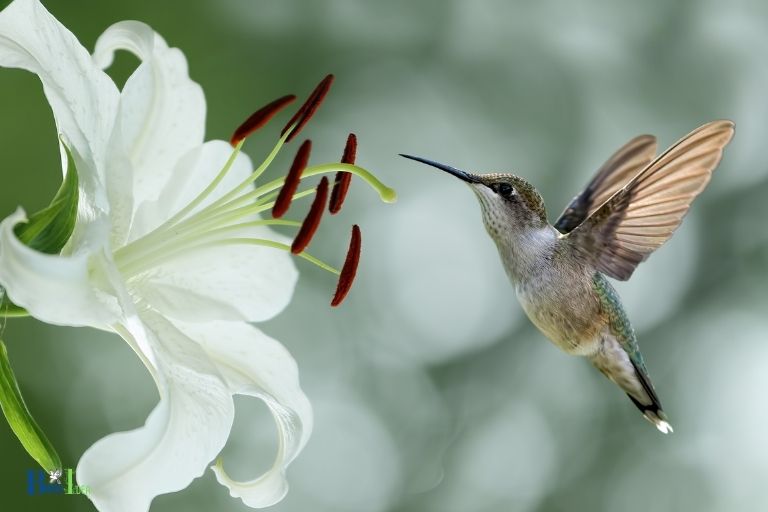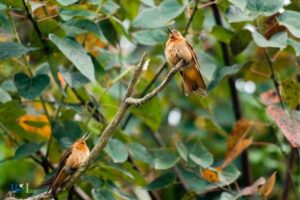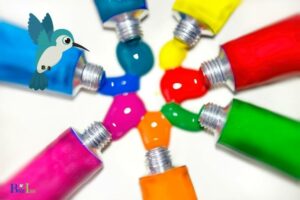How to Carve a Hummingbird? Sketch!
To carve a hummingbird, you need to start with a sketch, choose the right wood, use the appropriate carving tools, and follow the proper carving techniques to bring your hummingbird design to life.
Carving a hummingbird involves multiple steps that require attention to detail, patience, and practice.
You should start by drawing a sketch of the hummingbird to understand its anatomy, choose the appropriate wood for your project, and gather the right carving tools.
As you begin carving, follow a step-by-step process and use proper carving techniques to ensure a smooth and realistic depiction of the hummingbird.
Before you begin carving, it’s essential to study the anatomy of the hummingbird and create a detailed sketch to guide your work.
Make sure to choose a suitable wood material for your project, as some types of wood are easier to carve and more forgiving of mistakes. The most commonly used woods for carving birds are basswood and tupelo, due to their fine grain and ease of carving.
You’ll also need to gather the appropriate carving tools, such as a carving knife, chisels, gouges, and sandpaper.
As you work, follow a step-by-step process and practice proper carving techniques to ensure your hummingbird looks realistic and smooth.
10 Easy Step’s on How to Carve a Hummingbird
| Step | Tools | Instructions |
|---|---|---|
| 1 | Pencil and paper | Sketch the hummingbird design and identify key features to carve |
| 2 | Carving knife, wood or other carving material | Select the appropriate material and size for your hummingbird carving |
| 3 | Saw or bandsaw | Cut out the rough shape of the hummingbird from the material |
| 4 | Carving knife, gouge, V-chisel | Begin with the body of the hummingbird, carving out the basic shape and form. Don’t focus on details yet |
| 5 | Carving knife, gouge, V-chisel | Carve the wings and tail, ensuring they are proportional to the body and have the desired angles |
| 6 | Carving knife, detail knife | Add details to the wings, tail, and body, such as feather patterns, texture, and lines for added realism |
| 7 | Carving knife, detail knife | Carve the head, beak, and eye details |
| 8 | Sandpaper, fine grit | Gently sand the entire hummingbird carving to smooth out any rough edges and imperfections |
| 9 | Wood stain or paint, paintbrush | Apply the desired finish to your hummingbird carving, using wood stain or paint as needed |
| 10 | Sealant, paintbrush | Seal your hummingbird carving with a protective sealant to preserve your work and prevent damage |
Key Takeaway

Five Facts About: Hummingbird Carving
What You Need To Get Started
Carving a hummingbird can seem like a daunting task, especially if you’re new to woodworking.
However, with the right tools and materials, you’ll be able to create a stunning piece of art that captures the essence of this beautiful bird.
Here’s what you need to get started:
Explaining The Basic Tools
- Carving knife: The carving knife is the most important tool for any woodcarving project. Make sure that you have a sharp, reliable knife that is comfortable to hold for extended periods.
- Gouges: Gouges are specialized chisels that are designed to remove large amounts of wood quickly. There are many different types of gouges available, so choose the one that works best for your project.
- V-tool: V-tools are used for carving fine details such as feathers and fur.
- Mallet: A wooden or plastic mallet is essential for driving chisels and gouges into the wood.
- Sandpaper: Once you’ve finished carving, sandpaper is used to smooth out the rough edges of the piece.
Materials Required For Carving A Hummingbird
- Wood: Basswood and tupelo are both popular choices for carving hummingbirds. You can find these types of wood at your local woodworking store.
- Pattern: You’ll need a pattern to follow when carving your hummingbird. You can either create your own pattern or purchase one online.
- Carving wax: Carving wax is used to transfer the pattern onto the wood.
- Paint and finish: If you plan on painting your hummingbird, you’ll need acrylic paint and a clear finish to protect the paint.
Remember, the key to successful woodworking is to take your time and work carefully. With the right tools and materials, you’ll be able to create a stunning piece of art that will be treasured for years to come.
Steps For Carving A Hummingbird
Detailing Step-By-Step Process Of Carving A Hummingbird, From Selecting The Wood, To Sketching The Design, To The Final Touches
When it comes to carving a hummingbird, following a step-by-step process is crucial.
Here are the essential steps to ensure a successful project:
- Selecting the wood:
Before choosing your wood, decide how large or small you want your hummingbird to be. Basswood is a popular wood choice for beginners as it is soft and easy to carve. Once you have your wood, make sure it is free of knots or cracks for a smoother carving experience.
- Sketching the design:
Begin by drawing a rough hummingbird design on a piece of paper. Then, transfer the sketch to your wood by using a pencil or carbon paper. This process helps guide you while carving to achieve the desired outcome.
- Carving the block:
Start by carving the block to the rough shape of your hummingbird. Then, use a carving knife to create the details of the feathers and wings. Be patient and take your time as it is easy to make a mistake.
- Refining the details:
Once you have carved the general features of the hummingbird, take time to refine the details that will make it unique. Use small gouges and chisels to add detail to the feathers, wings, and eyes.
- Sanding and finishing:
Sand the hummingbird to ensure a smooth surface before applying the finish. Use a clear lacquer to protect and enhance the natural color of the wood. Add a hanging device or base to display your carving.
Tips And Tricks For Enhancing The Carving And Avoiding Common Mistakes
Here are some tips and tricks to improve your carving experience and avoid common mistakes:
- Before carving, warm up your hands and fingers by doing some light exercises or stretching. This helps avoid muscle cramps and strain.
- Invest in quality tools such as carving knives, gouges, and chisels. Dull and low-grade tools can cause accidents and damage your wood.
- Practice your cuts on a piece of scrap wood to prevent wasting time and resources.
- Keep your tools sharp and clean. Dull, dirty tools make it challenging to create clean lines and details.
- Be patient and take your time while carving. Rushing can cause accidents and mistakes.
- Be willing to make mistakes and learn from them. Even the most experienced carvers often make errors.
- Use reference images to inspire your design and details. Be creative and add unique features to your hummingbird, such as a flower or a different wing position.
Carving a hummingbird can be a rewarding and enjoyable experience for beginners and experts alike.
By following a realistic step-by-step approach and using the tips and tricks provided, you can create a beautiful piece of art that will impress and amaze anyone who sees it.
Happy carving!
Adding Detail To Your Hummingbird
Carving a hummingbird can be challenging, but once you have the basics of carving down, it’s time to add those intricate details that will make your hummingbird come to life.
In this section, we’ll discuss techniques for adding intricate features such as the eyes, beak and feathers to your hummingbird carving.
Adding Intricate Features
Adding intricate details to your hummingbird carving can be a daunting task if you’re new to carving.
These tips can help make the process easier:
- Master the basics first: Before you start working on the intricate details, make sure you have the basic shape of your hummingbird down. This includes proportionate wings, body and tail feathers and a well-formed beak.
- Create a template: A template is a great way to start planning out the intricate details of your hummingbird carving. Draw the details on a piece of paper or cardboard, cut them out, then trace them onto your carving. This will help ensure that the intricate features are proportional and in the right places.
- Use a carving knife: Carving knives are the perfect tool for adding intricate details to your carving. Use a sharp knife and make light, shallow cuts. Take your time and be patient. You can always go back and make deeper cuts later.
Eyes
The eyes of your hummingbird carving are one of the most important features. They bring the bird to life and give it personality.
To add eyes to your carving:
- Use a drill or dremel: A drill or dremel can be used to create the eye socket. Once you have the socket created, you can insert a small glass or plastic eye. Make sure the eye is centered in the socket and secure it with a drop of glue.
- Carve the eye directly into the bird: If you’re feeling confident, you can try carving the eye directly into the bird. Use a small knife or carving tool and make small, shallow cuts. Take your time and be patient. Once you have the general shape, smooth out the edges with sandpaper.
Beak
The beak of your hummingbird carving helps give it a sense of movement and action. It can be a little tricky to carve, but with practice, you’ll be able to create a beautiful beak.
To add a beak to your carving:
- Use a carving knife: Start by creating a rough shape of the beak with a carving knife. Be careful not to remove too much wood at first. Once you have the basic shape, use sandpaper to smooth out the edges and refine the shape.
- Add texture: Use a small carving tool or knife to add texture to the beak. Hummingbirds have small bumps and ridges on their beaks, so make sure to add those details to your carving.
Feathers
Feathers are what give your hummingbird carving its unique character and texture. They can be time-consuming to carve but are well worth the effort.
To add feathers to your carving:
- Create a template: A template can help you plan out the feathers before you start carving. Draw out the feathers on a piece of paper or cardboard and use it as a reference as you carve.
- Use a carving knife: A carving knife is the perfect tool for creating feathers. Start by making small, shallow cuts in the wood. As you work, deepen the cuts to create a more defined feather shape.
Carving a hummingbird takes time, patience, and lots of practice, but with these tips, you’ll be able to create an intricate and beautiful carving that you’ll be proud to show off.
Finishing Touches And Displaying Your Hummingbird
Carving a hummingbird is a fascinating hobby that requires focus and patience. Crafting a hummingbird from a block of wood is an impressive accomplishment, but it’s not complete until you give it some finishing touches and display it proudly.
Now let’s take a look at how to finish and display your hummingbird.
Describing How To Sand And Finish The Carving To Give It A Polished Look
After carving your hummingbird, you need to give it a polished finish.
Here are the steps:
- Start sanding with coarse-grit sandpaper and gently move towards a finer grit to smooth out the surface of your hummingbird.
- Apply wood sealer to the surface of your hummingbird and let it soak in for a few minutes. Then remove any excess with a clean cloth.
- After the sealer has dried, use a clean cloth to apply a thin layer of wood wax. Buff it up, and now your hummingbird is ready to be displayed.
Providing Creative Ideas For Displaying The Finished Hummingbird
Now that your hummingbird is complete, it’s time to show it off.
Here are some creative ideas to display it:
- Hang it on a wall in your home, creating some beautiful wall art or adding it to a gallery wall.
- Incorporate it into a centerpiece or add some rustic charm by displaying it on a wooden stand.
- Gift it to someone special, making it a thoughtful and unique present for any occasion.
- Attach a string or hook and hang it from your rearview mirror for a unique car accessory.
- Add a personal touch to your home’s holiday décor by displaying it on a christmas tree or as a thanksgiving centerpiece.
Finishing and displaying your hummingbird is the final step to perfecting this unique hobby. By following these simple steps, you’ll have a beautifully crafted hummingbird that you can proudly display and admire.
FAQ About How To Carve A Hummingbird
How Do I Choose The Right Wood For Hummingbird Carving?
What Tools Are Necessary To Carve A Hummingbird?
How Long Does It Take To Carve A Hummingbird?
Can A Beginner Carve A Hummingbird?
How Do I Finish A Carved Hummingbird?
Conclusion
Carving a hummingbird may seem like an intimidating task, but with the right tools, techniques, and patience, it can be a rewarding experience.
By following the steps outlined in this guide, you can create a beautiful piece of art that will impress your friends and family.
Remember to pay attention to the details, especially when it comes to the feathers and the beak. Practice makes perfect, so don’t be afraid to keep trying if you don’t get it right the first time.
With time and dedication, you can become an expert at carving hummingbirds and impress others with your skills.
So, get your tools ready, find a quiet and comfortable spot, and start carving your own little piece of nature. Happy carving!






